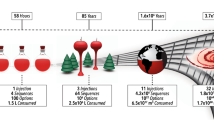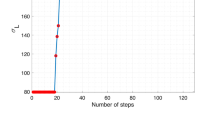Abstract
The rapid discovery of advanced functional materials is critical for overcoming pressing global challenges in energy and sustainability. Despite recent progress in self-driving laboratories and materials acceleration platforms, their capacity to explore complex parameter spaces is hampered by low data throughput. Here we introduce dynamic flow experiments as a data intensification strategy for inorganic materials syntheses within self-driving fluidic laboratories by the continuous mapping of transient reaction conditions to steady-state equivalents. Applied to CdSe colloidal quantum dots, as a testbed, dynamic flow experiments yield at least an order-of-magnitude improvement in data acquisition efficiency and reducing both time and chemical consumption compared to state-of-the-art self-driving fluidic laboratories. By integrating real-time, in situ characterization with microfluidic principles and autonomous experimentation, a dynamic flow experiment fundamentally redefines data utilization in self-driving fluidic laboratories, accelerating the discovery and optimization of emerging materials and creating a sustainable foundation for future autonomous materials research.

This is a preview of subscription content, access via your institution
Access options
Subscribe to this journal
Receive 12 digital issues and online access to articles
$119.00 per year
only $9.92 per issue
Buy this article
- Purchase on SpringerLink
- Instant access to full article PDF
Prices may be subject to local taxes which are calculated during checkout






Similar content being viewed by others
Data availability
All data supporting the findings of this study are available within the Article and its Supplementary Information. Source data are provided with this paper.
Code availability
The source code for the autonomous experimentation and digital twin models is available via GitHub at https://github.com/AbolhasaniLab in the ‘DynamicExperimentation’ repository.
References
Sadeghi, S. et al. Engineering a sustainable future: harnessing automation, robotics, and artificial intelligence with self-driving laboratories. ACS Sustain. Chem. Eng. 12, 12695–12707 (2024).
Kusne, A. G., McDannald, A. & DeCost, B. Learning material synthesis–process–structure–property relationship by data fusion: Bayesian co-regionalization N-dimensional piecewise function learning. Digit. Discov. 3, 2211–2225 (2024).
Schoenung, J. M., Olivetti, E. A. & Editors, G. Sustainable development of materials: broadening stakeholder engagement. MRS Bull. 48, 362–367 (2023).
Stier, S. P. et al. Materials acceleration platforms (MAPs): accelerating materials research and development to meet urgent societal challenges. Adv. Mater. 36, 2407791 (2024).
Delgado-Licona, F. & Abolhasani, M. Research acceleration in self‐driving labs: technological roadmap toward accelerated materials and molecular discovery. Adv. Intell. Syst. 5, 2200331 (2023).
Abolhasani, M. & Kumacheva, E. The rise of self-driving labs in chemical and materials sciences. Nat. Synth. 2, 483–492 (2023).
Flores-Leonar, M. M. et al. Materials acceleration platforms: on the way to autonomous experimentation. Curr. Opin. Green Sustain. Chem. 25, 100370 (2020).
Canty, R. B. et al. Science acceleration and accessibility with self-driving labs. Nat. Commun. 16, 3856 (2025).
Devi, R., Butler, K. T. & Sai Gautam, G. Optimal pre-train/fine-tune strategies for accurate material property predictions. npj Comput. Mater. 10, 300 (2024).
Ghosh, A. Towards physics-informed explainable machine learning and causal models for materials research. Comput. Mater. Sci. 233, 112740 (2024).
Karniadakis, G. E. et al. Physics-informed machine learning. Nat. Rev. Phys. 3, 422–440 (2021).
Chen, A. et al. Knowledge-reused transfer learning for molecular and materials science. J. Energy Chem. 98, 149–168 (2024).
Gupta, V. et al. Cross-property deep transfer learning framework for enhanced predictive analytics on small materials data. Nat. Commun. 12, 6595 (2021).
Fujinuma, N., DeCost, B., Hattrick-Simpers, J. & Lofland, S. E. Why big data and compute are not necessarily the path to big materials science. Commun. Mater. 3, 59 (2022).
Hayashi, H. et al. In silico reaction screening with difluorocarbene for N-difluoroalkylative dearomatization of pyridines. Nat. Synth. 1, 804–814 (2022).
McCullough, K., Williams, T., Mingle, K., Jamshidi, P. & Lauterbach, J. High-throughput experimentation meets artificial intelligence: a new pathway to catalyst discovery. Phys. Chem. Chem. Phys. 22, 11174–11196 (2020).
Schrier, J., Norquist, A. J., Buonassisi, T. & Brgoch, J. In pursuit of the exceptional: research directions for machine learning in chemical and materials science. J. Am. Chem. Soc. 145, 21699–21716 (2023).
Delgado-Licona, F., Addington, D., Alsaiari, A. & Abolhasani, M. Engineering principles for self-driving laboratories. Nat. Chem. Eng. 2, 277–280 (2025).
Epps, R. W. et al. Artificial chemist: an autonomous quantum dot synthesis bot. Adv. Mater. 32, 2001626 (2020).
Jha, P. et al. Photo‐induced bandgap engineering of metal halide perovskite quantum dots in flow. Adv. Mater. 37, 2419668 (2025).
Wu, T. et al. Self-driving lab for the photochemical synthesis of plasmonic nanoparticles with targeted structural and optical properties. Nat. Commun. 16, 1473 (2025).
Volk, A. A., Campbell, Z. S., Ibrahim, M. Y., Bennett, J. A. & Abolhasani, M. Flow chemistry: a sustainable voyage through the chemical universe en route to smart manufacturing. Annu. Rev. Chem. Biomol. Eng. 13, 45–72 (2022).
Zhang, K. et al. The importance of transport phenomena on the flow synthesis of monodispersed sharp blue-emitting perovskite CsPbBr3 nanoplatelets. Chem. Eng. J. 451, 138752 (2023).
López-Guajardo, E. A. et al. Process intensification 4.0: a new approach for attaining new, sustainable and circular processes enabled by machine learning. Chem. Eng. Process. Process Intensif. 180, 108671 (2022).
McMullen, J. P. & Wyvratt, B. M. Automated optimization under dynamic flow conditions. React. Chem. Eng. 8, 137–151 (2023).
Hone, C. A., Holmes, N., Akien, G. R., Bourne, R. A. & Muller, F. L. Rapid multistep kinetic model generation from transient flow data. React. Chem. Eng. 2, 103–108 (2017).
Mozharov, S. et al. Improved method for kinetic studies in microreactors using flow manipulation and noninvasive Raman spectrometry. J. Am. Chem. Soc. 133, 3601–3608 (2011).
Haas, C. P., Biesenroth, S., Buckenmaier, S., van de Goor, T. & Tallarek, U. Automated generation of photochemical reaction data by transient flow experiments coupled with online HPLC analysis. React. Chem. Eng. 5, 912–920 (2020).
Schrecker, L. et al. Discovery of unexpectedly complex reaction pathways for the Knorr pyrazole synthesis via transient flow. React. Chem. Eng. 8, 41–46 (2023).
Aroh, K. C. & Jensen, K. F. Efficient kinetic experiments in continuous flow microreactors. React. Chem. Eng. 3, 94–101 (2018).
Waldron, C. et al. Model-based design of transient flow experiments for the identification of kinetic parameters. React. Chem. Eng. 5, 112–123 (2020).
Van Herck, J. et al. Operator-independent high-throughput polymerization screening based on automated inline NMR and online SEC. Digit. Discov. 1, 519–526 (2022).
Van Herck, J. & Junkers, T. Rapid kinetic screening via transient timesweep experiments in continuous flow reactors. Chem. Methods 2, e202100090 (2022).
Moore, J. S. & Jensen, K. F. ‘Batch’ kinetics in flow: online IR analysis and continuous control. Angew. Chem. Int. Ed. 53, 470–473 (2014).
Florit, F. et al. Dynamic flow experiments for Bayesian optimization of a single process objective. React. Chem. Eng. 10, 656–666 (2025).
Sagmeister, P. et al. Accelerating reaction modeling using dynamic flow experiments, part 1: design space exploration. React. Chem. Eng. 8, 2818–2825 (2023).
Florit, F., Nambiar, A. M., Breen, C. P., Jamison, T. F. & Jensen, K. F. Design of dynamic trajectories for efficient and data-rich exploration of flow reaction design spaces. React. Chem. Eng. 6, 2306–2314 (2021).
Wyvratt, B. M., McMullen, J. P. & Grosser, S. T. Multidimensional dynamic experiments for data-rich process development of reactions in flow. React. Chem. Eng. 4, 1637–1645 (2019).
Williams, J. D., Sagmeister, P. & Kappe, C. O. Dynamic flow experiments for data-rich optimization. Curr. Opin. Green Sustain. Chem. 47, 100921 (2024).
Kanaris, A. & Mouza, A. Numerical investigation of the effect of geometrical parameters on the performance of a micro-reactor. Chem. Eng. Sci. 66, 5366–5373 (2011).
Klutz, S., Kurt, S. K., Lobedann, M. & Kockmann, N. Narrow residence time distribution in tubular reactor concept for Reynolds number range of 10–100. Chem. Eng. Res. Des. 95, 22–33 (2015).
López-Guajardo, E., Ortiz-Nadal, E., Montesinos-Castellanos, A. & Nigam, K. D. Coiled flow inverter as a novel alternative for the intensification of a liquid-liquid reaction. Chem. Eng. Sci. 169, 179–185 (2017).
Mridha, M. & Nigam, K. Coiled flow inverter as an inline mixer. Chem. Eng. Sci. 63, 1724–1732 (2008).
Saxena, A. & Nigam, K. Coiled configuration for flow inversion and its effect on residence time distribution. AlChE J. 30, 363–368 (1984).
Bateni, F. et al. Smart Dope: a self‐driving fluidic lab for accelerated development of doped perovskite quantum dots. Adv. Energy Mater. 14, 2302303 (2024).
MacLeod, B. P. et al. A self-driving laboratory advances the Pareto front for material properties. Nat. Commun. 13, 995 (2022).
Bai, Y. et al. Closed‐loop multi‐objective optimization for Cu–Sb–S photo‐electrocatalytic materials’ discovery. Adv. Mater. 36, 2304269 (2024).
Osterrieder, T. et al. Autonomous optimization of an organic solar cell in a 4-dimensional parameter space. Energy Environ. Sci. 16, 3984–3993 (2023).
Startt, J., McCarthy, M. J., Wood, M. A., Donegan, S. & Dingreville, R. Bayesian blacksmithing: discovering thermomechanical properties and deformation mechanisms in high-entropy refractory alloys. npj Comput. Mater. 10, 164 (2024).
McKay, M. D., Beckman, R. J. & Conover, W. J. A comparison of three methods for selecting values of input variables in the analysis of output from a computer code. Technometrics 42, 55–61 (2000).
Noack, M. M. et al. Autonomous materials discovery driven by Gaussian process regression with inhomogeneous measurement noise and anisotropic kernels. Sci. Rep. 10, 17663 (2020).
Liu, H., Cai, J., Ong, Y.-S. & Wang, Y. Understanding and comparing scalable Gaussian process regression for big data. Knowl. Based Syst. 164, 324–335 (2019).
Scott, M. & Su-In, L. A unified approach to interpreting model predictions. Adv. Neural Inf. Process. Syst. 30, 4765–4774 (2017).
Murray, C., Norris, D. J. & Bawendi, M. G. Synthesis and characterization of nearly monodisperse CdE (E = sulfur, selenium, tellurium) semiconductor nanocrystallites. J. Am. Chem. Soc. 115, 8706–8715 (1993).
Yang, H. et al. Continuous synthesis of full-color emitting core/shell quantum dots via microreaction. Cryst. Growth Des. 9, 4807–4813 (2009).
Xue, X., Huang, Y., Zhuang, Z., Huang, F. & Lin, Z. Temperature-sensitive growth kinetics and photoluminescence properties of CdS quantum dots. Cryst. Eng. Comm. 15, 4963–4969 (2013).
Epps, R. W., Volk, A. A., Abdel-Latif, K. & Abolhasani, M. An automated flow chemistry platform to decouple mixing and reaction times. React. Chem. Eng. 5, 1212–1217 (2020).
Acknowledgements
M.A. gratefully acknowledges financial support from the National Science Foundation (award nos. 1940959, 2315996 and 2420490) and the University of North Carolina Research Opportunities Initiative (UNC-ROI) program.
Author information
Authors and Affiliations
Contributions
F.D.-L. and M.A. conceived the project. F.B. and A.G. modified the precursor chemistry for flow synthesis. F.D.-L. and E.A.L.-G. designed the flow reactor geometry. F.D.-L., A.A., H.D. and M.A. designed and developed the flow synthesis platform. F.D.-L. programmed the automation and closed-loop experimentation protocols under the advisement of R.B.C. and J.A.B. F.D.-L., A.A., H.D., P.K. and A.G. conducted the experiments. F.D.-L. and A.A. conducted the data analysis under the advisement of M.A. F.D.-L., A.A., P.K. and N.M. prepared the data and setup visualization figures. P.J., N.M., J.L., A.G. and S.S conducted the ex situ characterization of the in-flow-synthesized samples. F.D.-L., A.A., H.D. and M.A. drafted the manuscript. M.A. acquired funding and directed the project. All authors provided feedback on the manuscript.
Corresponding author
Ethics declarations
Competing interests
The authors declare no competing interests.
Peer review
Peer review information
Nature Chemical Engineering thanks Adam Clayton, Jason Moore and the other, anonymous, reviewer(s) for their contribution to the peer review of this work.
Additional information
Publisher’s note Springer Nature remains neutral with regard to jurisdictional claims in published maps and institutional affiliations.
Extended data
Extended Data Fig. 1 Dynamic vs. Steady State Flow Experiments.
Two modes of data acquisition strategies for flow reactors for material synthesis are qualitatively compared: (a) traditional Steady State Flow Experiments (SSFE) and (b) Dynamic Flow Experiments (DFE). Dashed light gray frames represent an experiment, where the residence time is increased accordingly for each strategy. On top of each experiment frame, the collected data (sensor positioned at the end of the reactor) for each experiment is displayed. DFE captures all data during the continuous experiment, while SSFE captures data only at the end of the experiment when the steady state has been reached. Lastly, all data collected, from the start of the dynamic experiment (t = 0) to the end of the dynamic experiment (tf), can be mapped to steady-state residence time conditions, presented in both sections as the position inside the reactor that would experience the expected residence time in the reactor.
Supplementary information
Supplementary Information
Supplementary Sections 1–9, Figs. 1–9, Tables 1–5 and Discussion.
Source data
Source Data Fig. 1
Raw numerical data for all plots in Fig. 1.
Source Data Fig. 2
Raw numerical data for all plots in Fig. 2.
Source Data Fig. 4
Raw numerical data for all plots in Fig. 4.
Source Data Fig. 5
Raw numerical data for all plots in Fig. 5.
Source Data Fig. 6
Raw numerical data for all plots in Fig. 6.
Rights and permissions
Springer Nature or its licensor (e.g. a society or other partner) holds exclusive rights to this article under a publishing agreement with the author(s) or other rightsholder(s); author self-archiving of the accepted manuscript version of this article is solely governed by the terms of such publishing agreement and applicable law.
About this article
Cite this article
Delgado-Licona, F., Alsaiari, A., Dickerson, H. et al. Flow-driven data intensification to accelerate autonomous inorganic materials discovery. Nat Chem Eng 2, 436–446 (2025). https://doi.org/10.1038/s44286-025-00249-z
Received:
Accepted:
Published:
Issue date:
DOI: https://doi.org/10.1038/s44286-025-00249-z
This article is cited by
-
Learning the flow from the get-go
Nature Chemical Engineering (2025)



